When we fly between our homes in Illinois and Florida I always bring my camera and gear, which fills a standard carry-on suitcase. Quite heavy, it is a chore to lift into the overhead baggage compartment. I really don't mind going to all the trouble packing and unpacking, as we usually remain at either location for several weeks.
When taking a field trip which is designed to enjoy the wildlife, while it gets that perfect photo, a big camera can also get in the way. Even at home this arrangement can be somewhat unwieldy. When an unusual bird appears in our back yard, by the time I rush to retrieve and set up my camera it may be too late for a shot.
I thought about purchasing a second, smaller camera that I could carry on my pocket, one with respectable optical zooming power. It probably would not be useful for small creatures or at a great distance, but good enough to capture large birds or mammals, habitats and landscapes. Macro capabilities for flowers and insects mandatory.
An upcoming rail trip through Canadian Rockies spurred me to research the latest pocket cameras, and I settled on the Canon PowerShot SX700 HS. I still have no idea of what all those numbers and letters mean. My choice was based on the camera's features and multiple reviews thereof.
My big Canon 60D DSLR usually is fitted with a fixed 420 mm f/5.6 lens system. The SX700 sports a 30 power optical zoom, which produces the equivalent of a 450 mm lens on a 35 mm film camera. Out of the box, I ran a few tests at maximum zoom under varied lighting conditions.
The first subject for my new camera was a Killdeer at the side of the entrance drive into nearby Chapel Trail Nature Preserve as we waited for the gates to open. The bird was badly back-lit and only about 20 feet away, so its image filled the frame of the fully-extended lens. This was my first hand-held wildlife shot with my new camera just as it came out of the camera, a bit dark and badly shadowed:
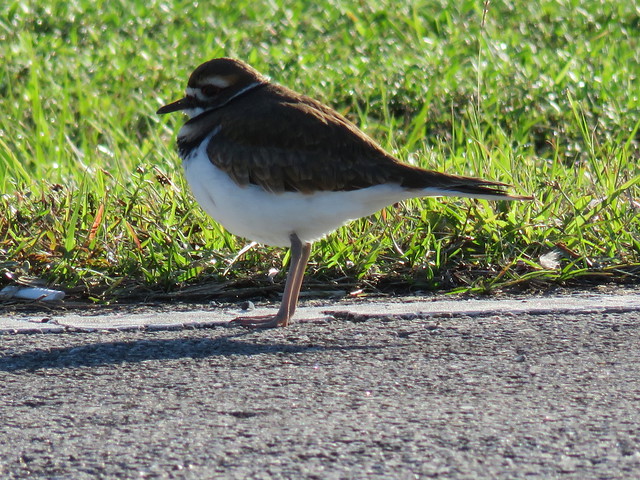
I processed the photo with Canon Digital Photography Professional (DPP) and this is the brightened and sharpened image:
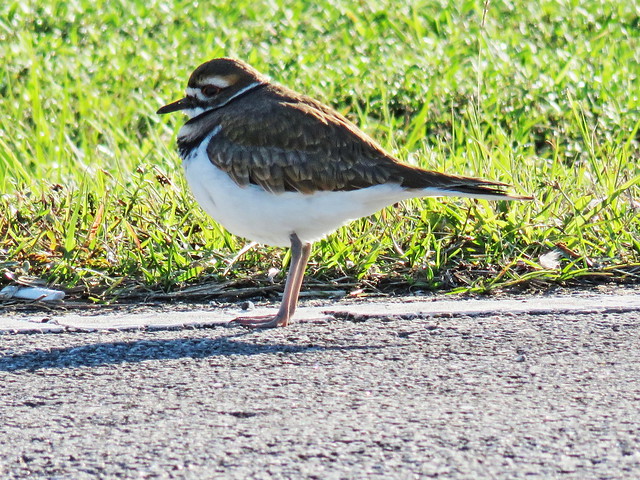
That photo seems good enough to document the sighting, and even bring back memories of the flock of a dozen Killdeers that surrounded our car that morning.
Another Killdeer was a bit more distant, perhaps at 30 feet, and in much better light. This is its uncropped but processed image:

The gate was supposed to open at 8:00 AM, and we waited until 8:30 before deciding to try another venue, Armstrong Dream Park, also in Pembroke Pines. This park includes a small lake that sometimes produces good birds during migration. Since it was now the beginning of winter, birding was slow.
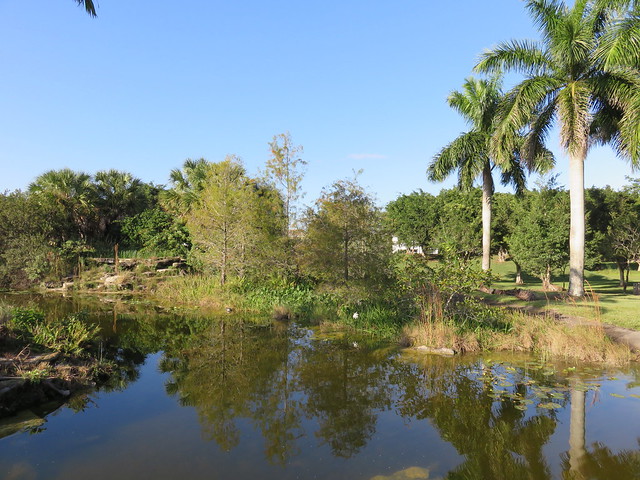
Look closely at the above photo, taken with the pocket camera without zooming in. Along the far shore, you may first see a white flower, and then to the left of center a turtle basking in the sun at the water's edge.
Here is that turtle, about 55-60 feet away, as captured by my new pocket camera, hand-held at full optical 30X (uncropped but processed normally with DPP):
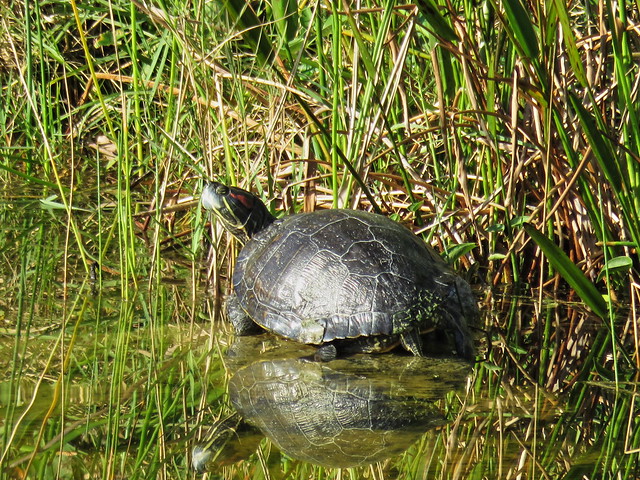
Here is the comparably processed shot from my Canon 60D DSLR with its 420mm lens system, using a monopod. The image came out smaller and with a wider format, so I cropped it slightly to provide a better comparison:
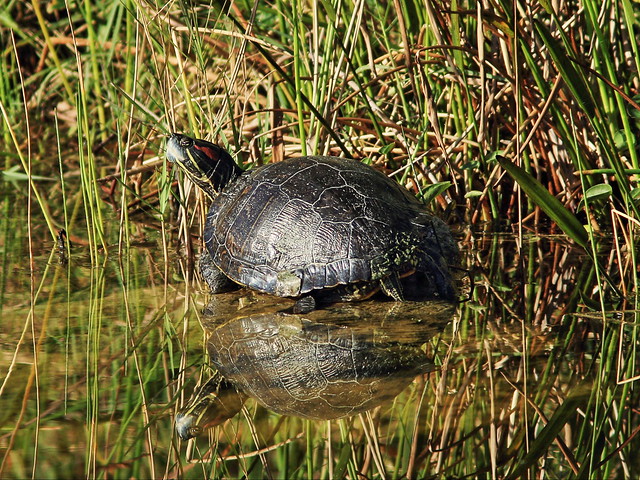
Here is the white flower, a Swamp Lily, taken with my DSLR:

On our way out in the parking lot I noticed an Osprey roosting about 225 feet away (as measured with Google Earth), atop the right-most light standard in the far distant center, protruding above the white auto (this is the un-zoomed image with the pocket camera):
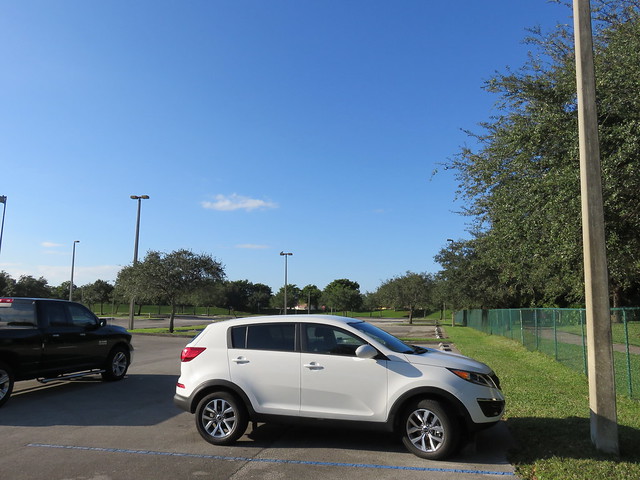
I zoomed the pocket camera up to 30 power and obtained this shot. This was the hand-held image as it appeared directly out of the camera, not cropped or processed:
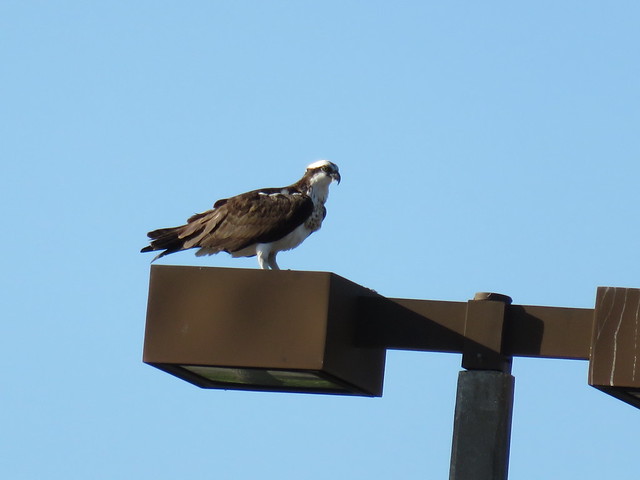
A bit of cropping and brightening produced this final product:
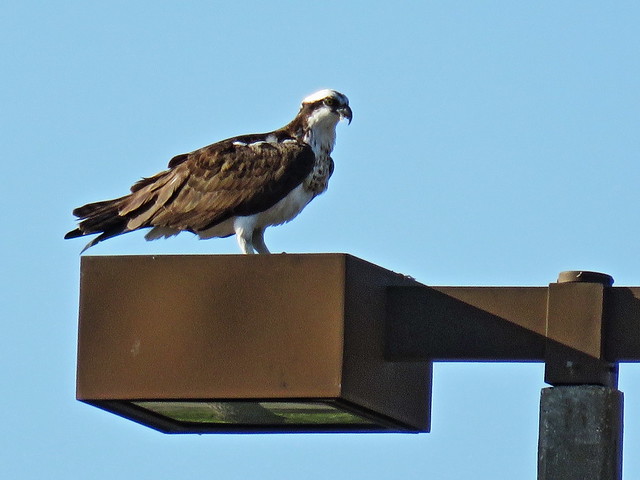
Finally, at Chapel Trail the next day I photographed this Great Egret with my DSLR on the monopod, at about 60 feet. I processed and trimmed both sides of the image but left it the same height to demonstrate relative size of the subject in each of the final products:
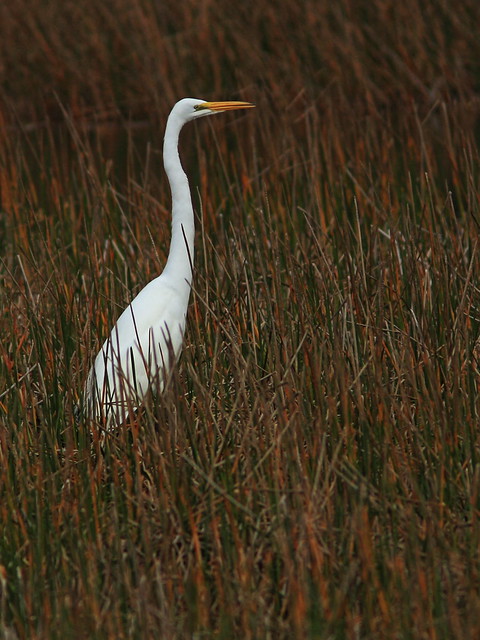
In the comparative pockt camera photo, the egret is magnified somewhat, due to the smaller sensor and the slightly greater effective magnification of its lens system at 30X (450 mm), hand-held:
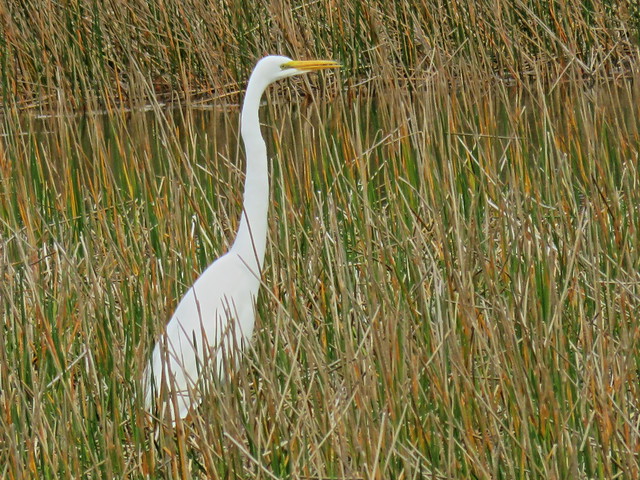
It is easy to see that the images of the pocket camera are softer, but I was rather surprised at how well the image stabilization works. Because of the small size of the camera's objective lens, the field of view is greatly restricted. At full power my hand shake caused the view to wobble wildly up and down and from side to side, sometimes entirely out of the LCD viewfinder.
In our back yard, I captured a Boat-tailed Grackle on the roof. Feather definition was pretty good:

A Muscovy Duck flew over the lake and I turned quickly to catch it. Luckily it appeared in the corner of the frame and was quite clear despite the blur due to the panning. This is a 1/4 crop from the original:
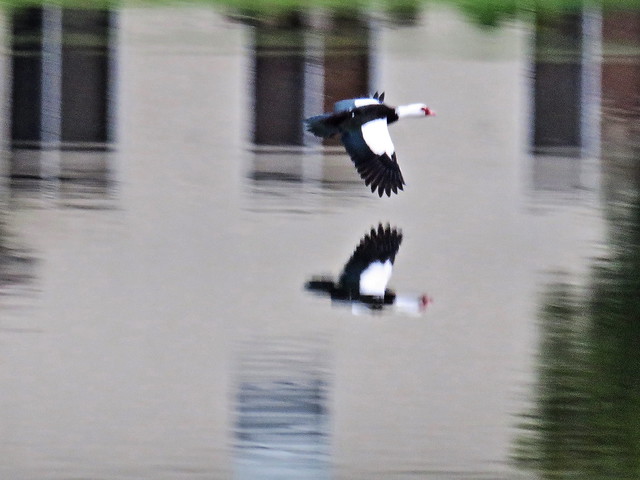
I feel this little camera's performance is good enough for me to leave my "big rig" behind during our next wildlife excursion.
Subsequent sample photos:
Animated GIF which combines several photos of a Northern Mockingbird at full 30X optical zoom uncropped and not processed.
HI Kenneth This is a great post illustrating how the small camera can 'nearly' be as good as the DSLR's. It is a problem as we get older also that we do not want all that weigh to carry around or round our necks. I think you have made a wise purchase. I would be interested to know how good a close up it can take? Perhaps another little experiment, just for me!!! Have a wonderful weekend with one or both cameras
ReplyDeleteBeautiful pic's from your new camera! I love the cute Killdeer! Great birds. Happy weekend!
ReplyDeleteAn interesting and informative post Ken with excellent comparative images.
ReplyDeleteI purchased a PowerShot SX50 HS, the much bulkier model, and have been pleased with its performance compared to my 450D plus 70-300 lens set up but on high zoom settings I definitely need to use a monopod.
pretty awesome zoom capability and without too much blur, either! i think i should give up my dslr. :)
ReplyDelete@ Margaret-- I have taken a few test macro shots but it has been windy and my attempts in the field to capture spiders and butterflies have not been satisfactory. Will keep trying!
ReplyDelete@ Frak-- The image stabilization is outstanding as you can see with the photo of the Muscovy Duck in flight. The camera was on full automatic settings. The intelligent focus tracks the object and keeps it in focus with no need to switch to a servo option. It will stabilize both horizontal and vertical shake. I have purchased a simple tripod mount that fits in the DSLR hot flash shoe and plan to mount the pocket camera on top of the main camera so that I can take both comparative shots using the same monopod. It will be interesting to see how mch this may help to sharpen the fully zoomed images.
HI Kenneth Thanks for the reply and perhaps if you do some more experimenting regarding macro, you will let me know please.
DeleteInteresting comparison. I have a powershot that I use for landscapes, but I prefer the olympus for birds and butterflies.
ReplyDeleteGreat post, and delighted to hear how effective the image stabilization is.
ReplyDeleteI use the Canon SX40HS. It's probably a little bigger than yours, but still portable. It beats carrying heavy equipment on long hikes and does an adequate job, but the DSLR cameras are superior, I think. I will eventually upgrade, but will continue to carry the smaller one on long hikes.
ReplyDeleteAlso, I'm sure you are already familiar with aperture. As you play with your new camera's features and get out of auto mode for some of your shots, I think you'll like your new camera even more.
ReplyDeleteI like doing pocket camera challenges too :) It's where you can really test your imagination and creativity. And amazing how you caught these birds (the first photos) without blur considering you weren't using a DLSR. *clap clap!*
ReplyDeleteInteresting post....I swear tho, those numbers...they confuse me to no end. I like the whole concept of point and shoot with a small but practical zoom. And these days, the more advanced the cameras become the less you need to lug around a huge, heavy camera and the tripod and all the extra lenses to get nearly the same results with a small pocket camera. As you proved. Well done. Very informative.
ReplyDeleteOh, and this is the very first time ever I've seen a muscovy duck fly!!! Around my neck of the woods they're always just lazing around or slowly strolling the park grounds. Excellent.
Thanks so much for linking in at the Bird D'Pot this weekend. Your participation is appreciated!!!
I think these turned out great.
ReplyDeleteNice post and review, Ken! Such a camera certainly has a niche and it's surprising how much the quality of output has improved over a fairly short amount of time.
ReplyDeleteThe camera is doing a fantastic job! Loved the photos, especially the crane in the grasses and those long zoom shots of the osprey!
ReplyDeleteI love the Osprey
ReplyDeleteMargaret commented on one of my photos posted on Google+ which was a composite of several photos I took of a Great Blue Heron.with the pocket camera. It may be viewed here:
ReplyDeleteGreat Blue Heron
Thanks, Margaret. Google automatically detects any series of similar photos and creates a composite (animated GIF file). You may remember when I posted on on my blog about the Hubbard Glacier. I used it as the fourth photo in this post: Hubbard Glacier
Great post with wonderful shots. My new favorite camera is the Canon SX50HS.
ReplyDeleteThis comment has been removed by the author.
ReplyDelete(Trying again) Here is an animated GIF from my Google+ page that combines several photos of a Northern Mockingbird taken at full 30X zoom, not cropped or processed: Northern Mockingbird
ReplyDelete